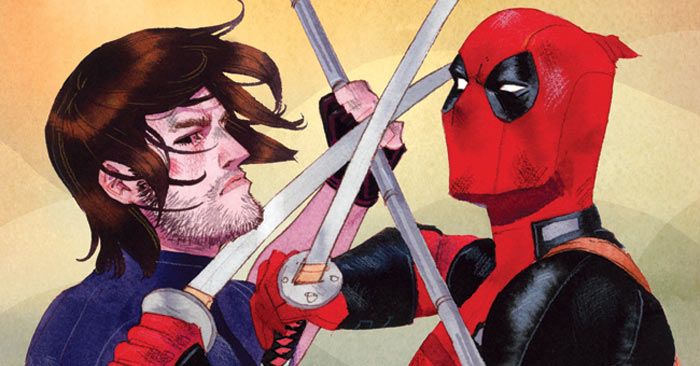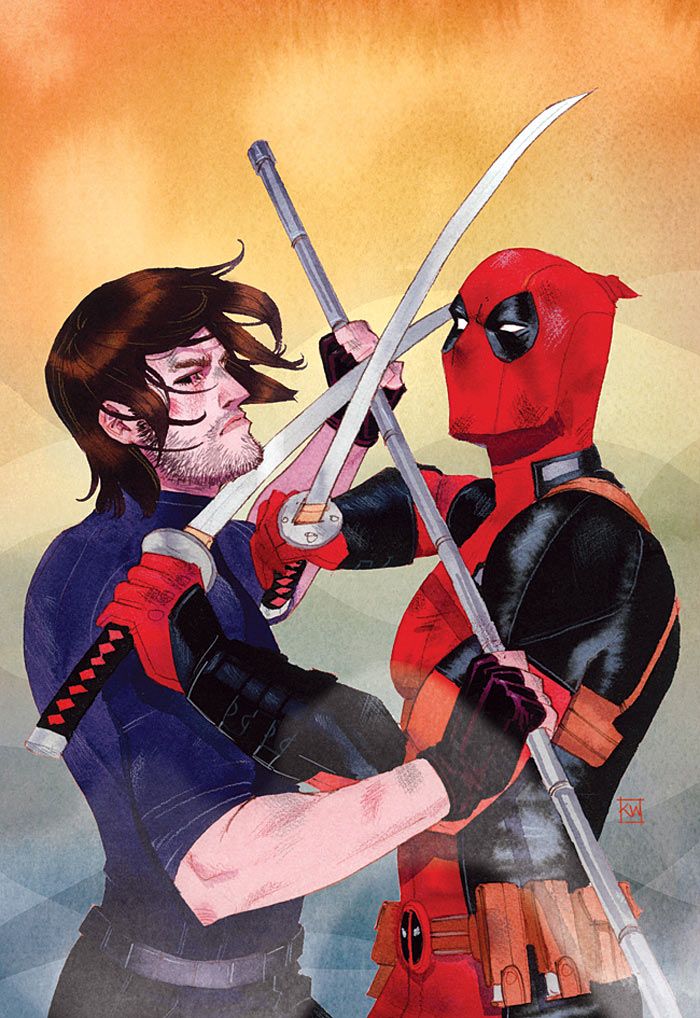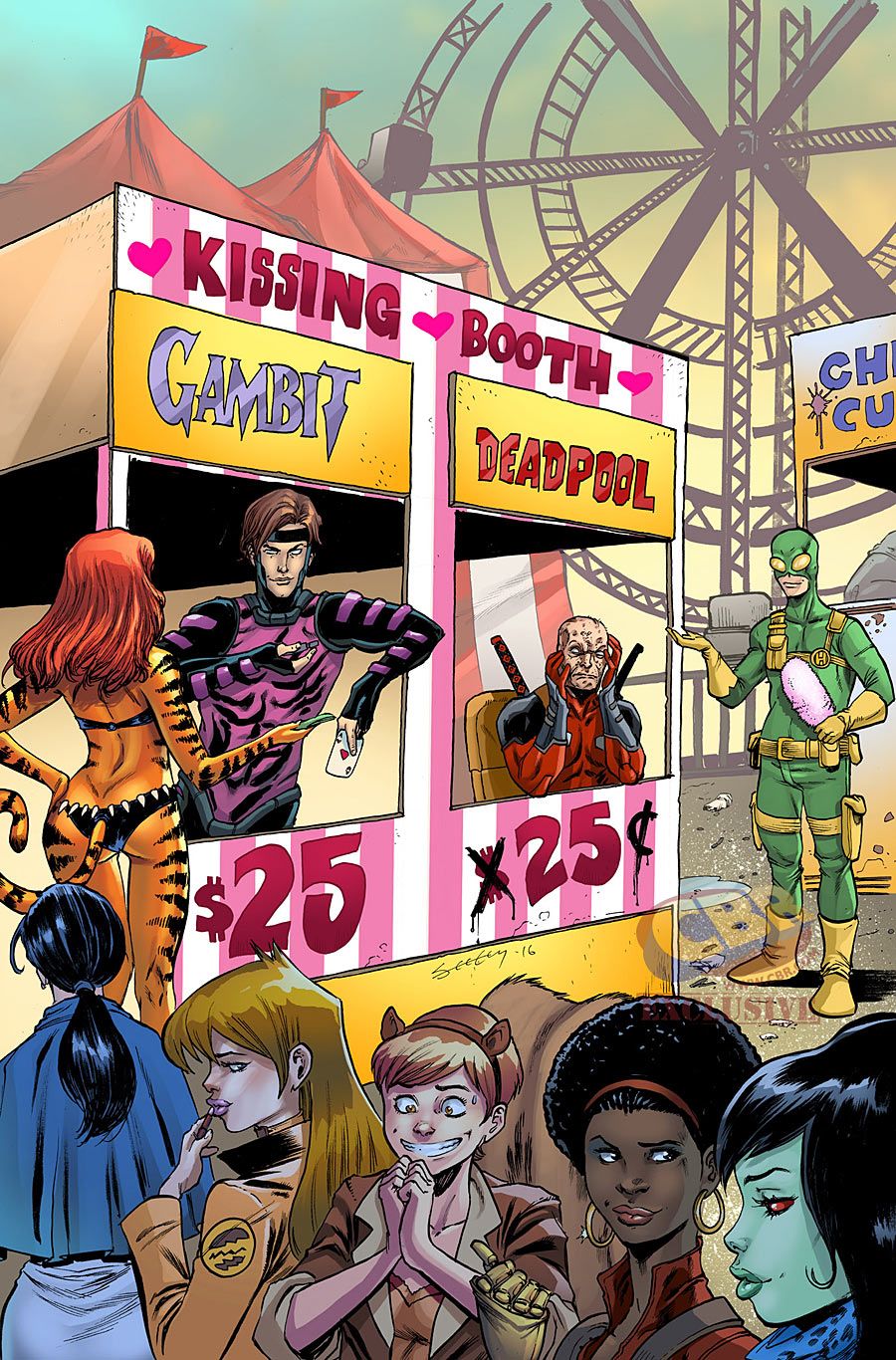Fighting alongside the Marvel Universe's premier super teams is good for the soul, but it doesn't always pay the bills or provide you with the lifestyle you desire. That's why, when he's not fighting alongside the X-Men or X-Factor, the mutant known as Gambit uses his powers and skills as a thief. It's also why the now world famous Deadpool uses his healing factor to earn a living as mercenary when he's not fighting alongside groups like his former teammates the Thunderbolts or current group the Uncanny Avengers. But can two money-motivated anti-heroes ever put aside their differences and work together for a larger payday?
RELATED: Marvel's "Deadpool vs. Gambit" Pits Merc Against Thief
This June, "Thrilling Adventure Hour" creators and former "Thunderbolts" writers Ben Acker & Ben Blacker and artist Danilo Beyruth kick off their five-issue "Deadpool v Gambit" miniseries (not a typo -- Marvel has dropped the title's "vs." for mysterious reasons), which finds the characters battling trust issues and a variety of super powered opponents as they work together on a high stakes con game.
CBR News spoke with Acker and Blacker about their take on why Deadpool and Gambit make such and interesting pair, the tone, structure and inspiration behind their story, and which familiar Marvel faces will be pulled into the title characters' scheme as unwitting pawns.
You guys have plenty of experience writing Deadpool as both a solo character and member of the Thunderbolts, but what made Gambit an intriguing character for you to write about? And what's it like bouncing him off a character like Deadpool?
Ben Blacker: I think there's a reason both characters have transcended their '90s origins. Deadpool and Gambit are, on their surface, shallow characters (like a lot of characters introduced in that era). But over the years, some really great writers have gotten their hands on them and added interesting layers. At root, what's interesting, to me at least, is that both characters have this sort of fun-seeking, hedonistic, narcissistic veneer, but underneath there's a lot of darkness, both in their origins and in their muddy moralities.
In both "Thunderbolts" and the other stuff we've written with Deadpool, we discovered Deadpool is a character who's most fun when he's bouncing off of a character very unlike himself -- someone like Punisher, say. So it's an interesting challenge to pair him with someone like Gambit who is just as shady and narcissistic as he is.
Ben Acker: I'm with Blacker here. Gambit and Deadpool strike me as personally motivated characters. Not cut from the "with great power comes great responsibility" cloth.
I read that "Deadpool v Gambit" is set in the past. Will you be dealing with some of their continuity and back story or is this more of a nebulous past time period?
Blacker: As with everything we do at Marvel, we don't want to get bogged down with too much company continuity. It was important to us that this be an accessible, self-contained story. So, it takes place at sort of an indeterminate time in the recent past. There are allusions to some Marvel events as they pertain to one of our antagonists, but other than that, we didn't worry too much about placing the story in a specific time period, as that's always slippery anyway.
Acker: We look at this book the way that Mr. Fraction did "Hawkeye" -- it's a Thursday. Gambit is between mutant obligations. Deadpool isn't doing any Thunderbolting. He's not part of any organization that would have him as a member. Running a con for these two is like a pickup game of basketball in the park. But it takes longer. And there's more planning. And a mark. And it's morally grayer than a lot of pickup games of basketball. But not one that, say Gambit or Deadpool might play. I expect that clarifies your "when" question completely.
RELATED: Acker & Blacker Escalate the Punisher's War Against the "Thunderbolts"
[Laughs] Narratively how is "Deadpool v Gambit" structured? Is each issue a different done-in-one caper or are you setting them up for one big score across the series?
Blacker: The structure was probably the most difficult challenge in writing this book. Con stories are really hard! I'd be giving too much away if I said there is one over-arcing con that's sort of made up of a bunch of different sizes and flavors of other cons. Or would I?
Acker: We're not doing a "caper of the month." That would have been easier. Blacker, we should have done a caper of the month. That would have been easier!
Other than the fact that a con will factor heavily, what kind of tone can readers expect? The announcement described the series as Deadpool and Gambit working together as con men just long enough to stab each other in the back, which of course has me thinking of the classic con man comedy "Dirty Rotten Scoundrels" -- but set in the Marvel U with Gambit in the Michael Caine role and Deadpool in the Steve Martin role. Is that anywhere close?
Blacker: The key to a con is trust, so that's the major theme of our story. It's about Gambit and Deadpool -- two characters who are solitary and generally unwilling to put faith in others -- figuring out how far and how much to trust each other. We looked at some of the best con and heist movies -- from "Oceans 11" to "The Brothers Bloom," "The Lady Eve," Mamet's con movies (which are terrific), "The Sting" of course -- but ultimately that was just to pile up tropes of the genre. In the end, a con in the Marvel Universe is very different to one in the "real" world of these movies. So we tried to marry those con tropes to superhero tropes and tie it together with the theme of trust. It's important to us that any story come from a place of character and the fun trope stuff is just metaphor and window dressing.
Acker: Blacker's right. We did way too much research. I spent a day down a rabbit hole about Cajuns. Interesting stuff, none of which will make the comic. As to your question about whether this book is "Dirty Rotten Scoundrels" in different costumes -- it totally isn't.
How much fun are you having with settings in "Deadpool v Gambit?" It seems like the premise allows for some globetrotting and jet setting. What can you tell us about some of the locales these heroes will visit?
Blacker: Obviously we had to set part of the story in New Orleans, as that's not just where Gambit comes from but it's a beautiful and fun place to set a con story. There's so much culture to draw from there for set-pieces. There are a couple of locations we can't tell you about as it'll tip some story elements, but man, I can't wait to see Danilo's take on these Marvel mainstay locales. The first issue takes place in New York, and Acker did some great research and talked to our friends who live there and came up with some very specific and funny setpieces there.
Acker: John Hodgman will be receiving a cartographic consultation credit. I had a moment where I got mad at fictional characters for going to New Orleans where I have never been and would very much like to go.
Who are some of the supporting characters and antagonists that your protagonists will run into? Can we expect plenty of faces from their past or will they be encountering some new faces?
Blacker: I feel like these five issues are a who's who of obscure Marvel heroes and villains. Because of the nature of the con, we needed some characters with very specific powers or skill sets. Luckily, Marvel has this enormous stable of great characters, and most of the ones we needed were available. We really can't tell too much. But in addition to the characters we pulled out of obscurity, you'll see Spider-Man and Daredevil. They have a key sequence in the first issue in which they enjoy a cup of coffee together.
Acker: There may or may not be the presence of a character we may or may not have created who is a lawyer and a Hulk.
Artist Danilo Beyruth has recently drawn some fun comedy-action caper stories involving Howard the Duck and Gwenpool, and Deadpool and Hawkeye. So it seems like he'd be a great fit for what you guys are doing here. And with Kevin Wada you have an artist who can deliver some fantastic and expressive covers. What do you enjoy most about Danilo and Kevin's styles?
Blacker: We had a great experience working with Danilo on our 10-page Slapstick story in "Deadpool" #7, so we were thrilled when [editor] Jordan [D. White] said he'd gotten him again for this series. I think Danilo is a great artist for this sort of story because his art is right on the edge of cartoony -- you still believe the characters to have real emotions, but he nails the comedy of every scene. He's really stretching on this book, too, as we had some rather demanding storytelling (again, due to the nature of this sort of story); his pages are coming in now, and they're just killer.
And Kevin [Wada]'s work is unlike anyone else's out there. His covers are almost like Italian wall friezes. There's an entire story in just one image.
I cannot say enough how much "Deadpool v Gambit" is a wild, weird ride. There's a turn in issue #3 that we came up with that I cannot believe we're being allowed to execute. It's just that silly. I think people will get a kick out of this story.
Acker: Blacker loves one of the turns in issue #3. I'm more of an issue #4 guy. I can't believe we're allowed to do issue #4. And there's something in issue #5 that we're totally not allowed to do. We have been told unequivocally that we're not allowed to do it, but guess what? We're totally doing it. I would like to point out that issues #1 and #2 are really fun too.
"Deadpool v Gambit" starts scheming this June from Marvel Comics.



